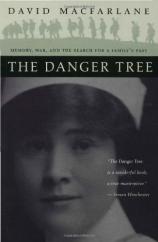Reading Group Guide
Discussion Questions
The Danger Tree: Memory, War, and the Search for a Family's Past

1. Macfarlane writes that "the Goodyear family history is almost impossible to trace." Yet he does just that. How does he manage to construct a remembered past despite a scarcity of records and the ultimate unreliability of family stories and memories? What does he have to say about the fragility and unreliability of memory?
2. How did Newfoundland's history, economy, and politics—as a British colony and, later, a Canadian province—affect the Goodyear family and its members' hopes, ambitions, and expectations? How have they influenced Macfarlane's portrait of his forebears?
3. How might the kinds of links that the Goodyears saw as connecting Grand Falls to the outside world be seen by residents of other small communities today as connecting them to the greater world? To what degree are the residents of such communities justified in considering themselves as dynamic, integral components of a larger world—as places "of some consequence"?
4. What aspects of life in Grand Falls and Newfoundland's outports are particularly memorable or important? What qualities of life strike you as having been the most significant in shaping individual lives and communal culture?
5. Why was Louisa Goodyear's insistence that her family move from Ladle Cove to Grand Falls particularly audacious? In what ways was the family's "abrupt, one-way journey" transformative? What is emblematic about the move in respect to both the history of the Goodyear family and the history of Newfoundland?
5. "The features of a man," Macfarlane writes, "no matter how much a fool he had been in life, often settled to a heroic grandeur in death." What actual instances of this does he present? Why, in Macfarlane's view, is it not true of women? To what extent, however, might this settling to heroic grandeur be true of both the Goodyear women and men whom Macfarlane portrays?
7. How successful is Macfarlane in conveying the World War I battlefield experiences of the Goodyears and other members of the Newfoundland Regiment? What details of his description of war are most meaningful, and why?
8. Why do you think Macfarlane, rather than presenting a straightforward narrative, constantly shifts back and forth among various personal, family, historical, and imagined pasts, and interjects seemingly unrelated anecdotes and family stories into his history? How might the juxtapositions and interweaving patterns of his method reflect the operations of family and national history and memory?
9. Macfarlane says of his mother and her family that, "in general, their reminiscences lament the present and mourn the past." To what extent is this also true of The Danger Tree? What other approaches to past and present do you think are possible?
10. Macfarlane comments that he had expected to inherit his own share of Newfoundland from his grandfather. In lieu of that share, what did he inherit? In what sense can we say that, in fact, he did inherit his own share of Newfoundland?
11. How do accounts of such events as the Gallipoli campaign, the sinking of the Titanic, and other historical events serve to place Macfarlane's account of the Goodyear family within a wider historical context? What analogies does Macfarlane establish between Newfoundland and the greater world, as experienced by the Goodyears (for example, the charred trees outside Ypres and the burned trees of Newfoundland's interior).
12. In what ways did the World War I deaths of Hedley, Stan, and Ray Goodyear cast everything David Macfarlane "would ever hear and learn about the Goodyears...into high relief"? "They made everything seem important," he writes. How does this claim become manifest in his book? Why should these three deaths, and the resulting three absences, define the very center of The Danger Tree?
13. What was "the greatest change" that the trench warfare of World War I brought to the Goodyears, Newfoundland, and the world, and why was it "one that no one could measure"?
14. Macfarlane writes that the trans-Newfoundland railway, although intended to unite the island, in fact "pulled the country in opposite directions." What other contradictions and paradoxes of Newfoundland history and culture does the author identify? How have Newfoundlanders coped with those contradictions and paradoxes.
15. Macfarlane writes that his grandfather "did have something of the unruffled independence of mind that characterizes the archetypal Newfie." What are some other characteristics of "the archetypal Newfie," and how are those characteristics evident in the lives and behavior of the Goodyears?
16. What value does the author attach to remembering, recording, and reconstructing one's family history? What value do you attach to such activities? In what ways might The Danger Tree prompt readers to revise their views of family history and the worthiness of recording it?
17. To what extent, in the course of Macfarlane's book, does Newfoundland become synonymous with No Man's Land? What images and references does he include—for example the comparison of Newfoundland's burned-over forests with the Somme battlefield—to reinforce that comparison?
18. How do the structure and forward movement of The Danger Tree reflect the ways in which the past weighs on the present andthe ways in which historical events of national and international importance affect family and individual lives?
The Danger Tree: Memory, War, and the Search for a Family's Past
- Publication Date: April 1, 2001
- Paperback: 307 pages
- Publisher: Walker & Company
- ISBN-10: 0802776167
- ISBN-13: 9780802776167






